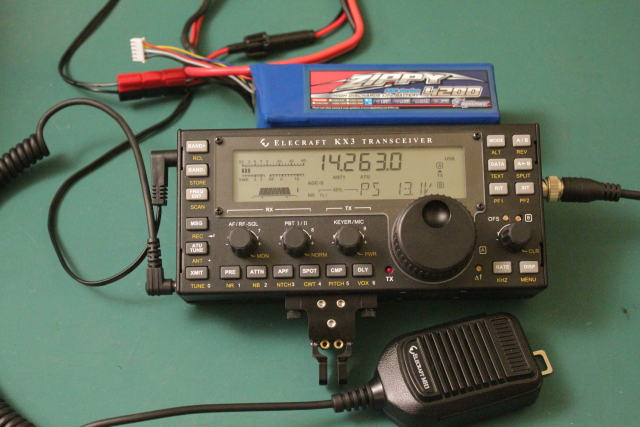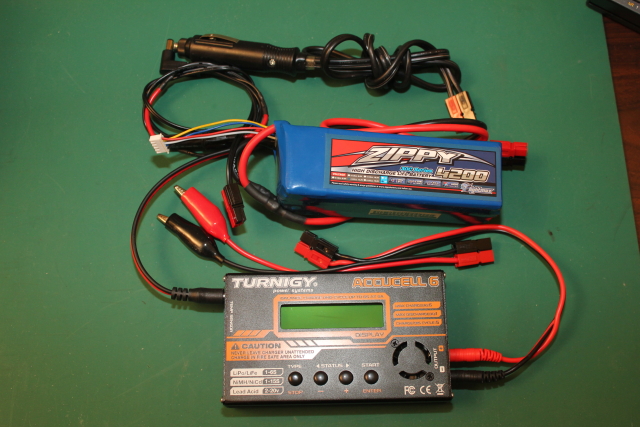In my opinion, one of the best features of the Elecraft KX3 is the very flexible power capability - the rig is rated to operate between 8 and 15 volts and will typically only draw 1 -2 amps during transmit and as low as 150 mA during receive.
While the transceiver can accept 8 AA size batteries and will soon have an internal NiMH batter charger, serious portable operators will quickly desire the capacity that only larger battery packs can supply. Fortunately, the market desiring light weight, quick charging, powerful baterry packs is not limited to ham radio operators; the Radio Controlled hobbies have been driving the demand for these products for some time.
I recently purchased a battery pack and charger that has completely transformed my KX3 capabilities.

The battery pack I purchased is a 4200mAh 4S2P (4 batteries in series, and 2 banks in parallel) LifePO4 pack intended for RC planes and cars: HobbyKing R/C Hobby Store : ZIPPY Flightmax 4200mAh 4S2P 30C LiFePo4 Pack
The charged voltage of this pack is 13.2 volts, well within the specs of the KX3. At approximately $40, this battery pack is half the price of the equivalent pack that Buddipole sells! Weighing only 558 grams (19 ounces), this battery pack will barely be felt when added to your backpack. As you can see from the picture, the battery pack is even much smaller than the KX3.
You need a special charger for these batteries: It needs to charge at the correct rate (or risk explosion!) and the chargers also balance the individual cells using the smaller supplied connector. I purchased this Turnigy charger for $23: HobbyKing R/C Hobby Store : Turnigy Accucel-6 50W 6A Balancer/Charger w/ accessories
These chargers are DC powered, which means that you can charge them from an existing power supply or even your car power while driving to your operating destination. Keep in mind that these chargers and batteries are equipped with connectors common to the RC industry, so you will probably want to fit all of the wires with Anderson Power Poles. The charger / battery combination recharges a battery quite fast: it's not uncommon to charge a dead battery pack in under an hour!
In this picture, you can see that I've rigged up multiple power options for the KX3, everything containing power poles for ultimate flexibility:

This setup allows me to power the Turnigy charger directly from a power supply, a cigaratte adapter, or clipped directly to a car batery. Likewise, I can power the KX3 from the battery, a cigarette lighter, a direct 12v source like a power supply, or also clipped directly to a car battery.
I've yet to find the total discharge time of this 4S2P battery pack, although I will report back when I do. So far I have more than 6 hours of RX time mixed in with about 1 hour of total talk time. The voltage is holding steady at 13 volts. I love this little battery pack and will probably buy another soon!
While the transceiver can accept 8 AA size batteries and will soon have an internal NiMH batter charger, serious portable operators will quickly desire the capacity that only larger battery packs can supply. Fortunately, the market desiring light weight, quick charging, powerful baterry packs is not limited to ham radio operators; the Radio Controlled hobbies have been driving the demand for these products for some time.
I recently purchased a battery pack and charger that has completely transformed my KX3 capabilities.

The battery pack I purchased is a 4200mAh 4S2P (4 batteries in series, and 2 banks in parallel) LifePO4 pack intended for RC planes and cars: HobbyKing R/C Hobby Store : ZIPPY Flightmax 4200mAh 4S2P 30C LiFePo4 Pack
The charged voltage of this pack is 13.2 volts, well within the specs of the KX3. At approximately $40, this battery pack is half the price of the equivalent pack that Buddipole sells! Weighing only 558 grams (19 ounces), this battery pack will barely be felt when added to your backpack. As you can see from the picture, the battery pack is even much smaller than the KX3.
You need a special charger for these batteries: It needs to charge at the correct rate (or risk explosion!) and the chargers also balance the individual cells using the smaller supplied connector. I purchased this Turnigy charger for $23: HobbyKing R/C Hobby Store : Turnigy Accucel-6 50W 6A Balancer/Charger w/ accessories
These chargers are DC powered, which means that you can charge them from an existing power supply or even your car power while driving to your operating destination. Keep in mind that these chargers and batteries are equipped with connectors common to the RC industry, so you will probably want to fit all of the wires with Anderson Power Poles. The charger / battery combination recharges a battery quite fast: it's not uncommon to charge a dead battery pack in under an hour!
In this picture, you can see that I've rigged up multiple power options for the KX3, everything containing power poles for ultimate flexibility:

This setup allows me to power the Turnigy charger directly from a power supply, a cigaratte adapter, or clipped directly to a car batery. Likewise, I can power the KX3 from the battery, a cigarette lighter, a direct 12v source like a power supply, or also clipped directly to a car battery.
I've yet to find the total discharge time of this 4S2P battery pack, although I will report back when I do. So far I have more than 6 hours of RX time mixed in with about 1 hour of total talk time. The voltage is holding steady at 13 volts. I love this little battery pack and will probably buy another soon!







